
Amphibians are ectothermic, anamniotic, four-limbed vertebrate animals that constitute the class Amphibia. In its broadest sense, it is a paraphyletic group encompassing all tetrapods, excluding the amniotes. All extant (living) amphibians belong to the monophyletic subclass Lissamphibia, with three living orders: Anura (frogs), Urodela (salamanders), and Gymnophiona (caecilians). Evolved to be mostly semiaquatic, amphibians have adapted to inhabit a wide variety of habitats, with most species living in freshwater, wetland or terrestrial ecosystems. Their life cycle typically starts out as aquatic larvae with gills known as tadpoles, but some species have developed behavioural adaptations to bypass this.

A frog is any member of a diverse and largely carnivorous group of short-bodied, tailless amphibians composing the order Anura. The oldest fossil "proto-frog" Triadobatrachus is known from the Early Triassic of Madagascar, but molecular clock dating suggests their split from other amphibians may extend further back to the Permian, 265 million years ago. Frogs are widely distributed, ranging from the tropics to subarctic regions, but the greatest concentration of species diversity is in tropical rainforest. Frogs account for around 88% of extant amphibian species. They are also one of the five most diverse vertebrate orders. Warty frog species tend to be called toads, but the distinction between frogs and toads is informal, not from taxonomy or evolutionary history.
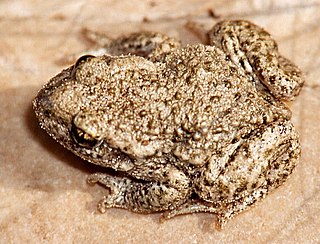
The Alytidae are a family of primitive frogs. Their common name is painted frogs or midwife toads. Most are endemic to Europe, but three species occur in northwest Africa, and a species formerly thought to be extinct is found in Israel.
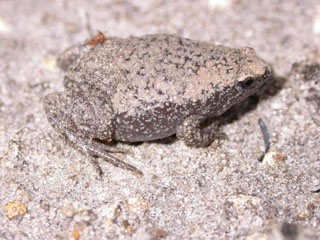
The Microhylidae, commonly known as narrow-mouthed frogs, are a geographically widespread family of frogs. The 683 species are in 57 genera and 11 subfamilies.

A true toad is any member of the family Bufonidae, in the order Anura. This is the only family of anurans in which all members are known as toads, although some may be called frogs. The bufonids now comprise more than 35 genera, Bufo being the best known.

Cophylinae is a subfamily of microhylid frogs endemic to Madagascar. It has over 100 species in eight genera. Members of this subfamily range from minute to fairly large, and they are highly ecologically diverse. DNA barcode research has revealed a significant taxonomic gap in this subfamily, and an estimated 70+ candidate species were identified. Many of these have subsequently been described, as well as numerous new discoveries.

Plethodontohyla is a genus of microhylid frogs endemic to Madagascar.

Cophixalus is a genus of microhylid frogs. These are arboreal species with expanded toe-pads, endemic to Moluccan Islands, New Guinea and northeastern Queensland, Australia.
Copiula is a genus of microhylid frogs endemic to New Guinea. The common name Mehely frogs has been coined for them. They are leaf-litter inhabitants.
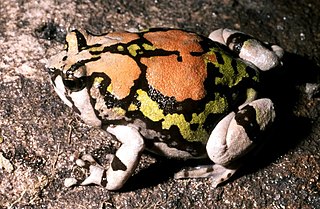
Scaphiophryne is a genus of microhylid frogs endemic to Madagascar. Some of the species are strikingly marked, while others are highly cryptic. They are rather plump and generally found on the ground. Several species in the genus are threatened because of habitat loss and overcollection for the international pet trade.
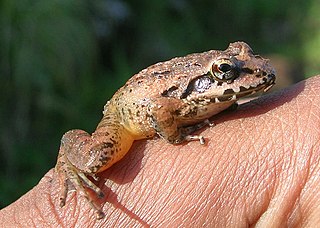
Indirana is a genus of frogs in the family Ranixalidae. These frogs are endemic to the Western Ghats of India. They are sometimes known under the common name Indian frogs, whereas members of their parent family are named "leaping frogs".
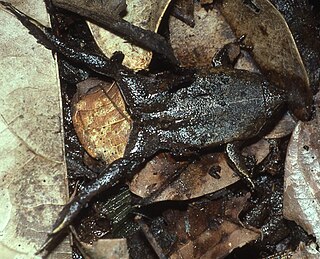
Ctenophryne is a genus of microhylid frogs. They occur in southern Central America and South America. Their common names are egg frogs and Nelson frogs, the latter applying to species in the formerly recognized Nelsonophryne.
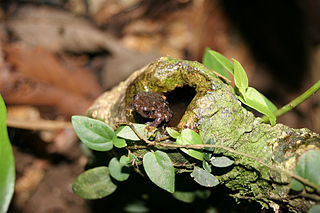
Metaphrynella is a small genus of microhylid frogs from the southern Malay Peninsula and Borneo. They are sometimes known as the Borneo treefrogs or tree hole frogs. The common name refers to the microhabitat of these frogs: males call from tree holes and tadpoles develop in the water contained in those holes.

Phytotriades is a genus of tree frogs in the family Hylidae. As currently delimited, the genus is monotypic and contains Phytotriades auratus, commonly known as the golden tree frog, bromeliad-dwelling treefrog, El Tucuche golden tree frog, or Trinidad heart-tongued frog.

Hamptophryne is a small genus of microhylid frogs from South America. The genus was previously monotypic, but because of the close phylogenetic relationship between Hamptophryne and Altigius, another monotypic genus, the latter was placed in synonymy with Hamptophryne in 2012.
Otophryne robusta is a species of frog in the family Microhylidae. It is found in Guyana, Venezuela, and possibly Brazil. Its natural habitats are tropical moist montane forests and rivers. It is threatened by habitat loss.
Otophryne steyermarki is a species of frog in the family Microhylidae. It is found in western Guyana and in the Bolívar state in eastern Venezuela.

The Petropedetidae are a family of frogs containing three genera and 12 species. They are found in sub-Saharan tropical Africa and are sometimes known under common name African torrent frogs.

Brevicipitidae or rain frogs is a small family of frogs found in eastern and southern Africa. As of 2020 contains 37 species in 5 genera. Formerly included as subfamily in Microhylidae, phylogenetic research has indicated the brevicipitine frogs should be considered as a family with Hemisotidae as the most closely related sister taxon.
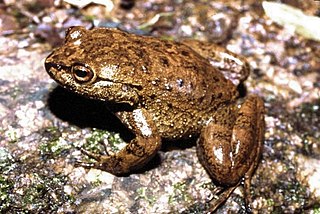
Phantasmarana is a genus of frogs in the family Hylodidae. The genus is endemic to the Atlantic Forest of southeastern Brazil.

















